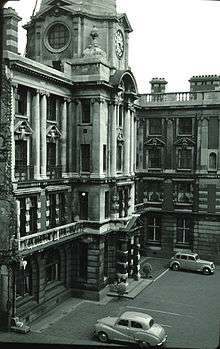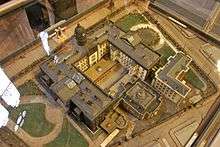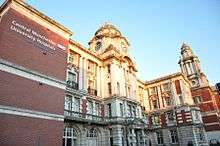Manchester Royal Infirmary
| Manchester Royal Infirmary | |
|---|---|
| Central Manchester University Hospitals NHS Foundation Trust | |
 The MRI's main building in 1957 | |
| Geography | |
| Location | Chorlton on Medlock, Manchester, North West England, United Kingdom, England |
| Organisation | |
| Care system | NHS |
| Hospital type | Teaching |
| Affiliated university | Manchester Medical School |
| Services | |
| Emergency department | Yes Level 1 Trauma Center |
| Beds | 750 or more[1][2] |
| History | |
| Founded | 1752 |
| Links | |
| Website | http://www.cmft.nhs.uk/ |
| Lists | Hospitals in England |
The Manchester Royal Infirmary (MRI) is a hospital in Manchester, England, which was founded by Charles White in 1752 as a cottage hospital capable of caring for twelve patients. Manchester Royal Infirmary is part of a larger NHS Trust incorporating several hospitals called Central Manchester University Hospitals NHS Foundation Trust.
The hospital today
Manchester Royal Infirmary now has over 750 beds.
- Manchester Royal Infirmary itself specialises in cardiology, in renal medicine and surgery, and in kidney and pancreas transplants. Its A&E department deals with around 145,000 patients every year.[3]
History
Town centre

Its first premises was a house in Garden Street, off Withy Grove, Manchester. It grew in importance and needed to expand, the infirmary moved to considerably larger premises on Lever's Row in the area now known as Piccadilly Gardens (the gardens were only created after the demolition of the former MRI buildings in 1914). The site was donated by the Lord of the Manor and had previously been called the Daub Holes: these pits had filled with water and they were replaced by a fine ornamental pond.[4] The new building was opened in 1755 and by the late 19th century statues had been installed on the esplanade on the northern side while the streets to the south beyond Parker Street were narrow.[5] White co-founded the Manchester Royal Infirmary with local industrialist Joseph Bancroft in 1752, and was an honorary surgeon there until 1790.[6] In an adjacent building was the Lunatic Asylum, established in 1763; in 1849 the asylum was removed to Cheadle, Cheshire. Students in the nineteenth century were awarded external degrees by the University of London.[7]
A library was established in the Infirmary in 1791; a catalogue of the library was compiled by Frank Renaud and published in 1859.[8] A collection of books from the library was donated to the Medical Library of the university in 1917.
The Manchester Infirmary was renamed as the Manchester Royal Infirmary in 1830.[9]
Oxford Road

A fire in nearby buildings showed hospital staff that the crowdedness of the area would badly hamper evacuation if there was a fire in the hospital. In 1908, in partnership with the Victoria University of Manchester, it relocated to its present site on Oxford Road, opposite Whitworth Park; it was opened by King Edward VII. The years of World War II were busy and bomb damage destroyed parts of the building.[10]
The buildings have been very much enlarged in the last 25 years: in summer 2009 came the latest additions, a new children's hospital and a new eye hospital.
See also
References
- ↑ "Manchester Royal Infirmary, Manchester". Retrieved 2007-06-20.
- ↑ "MRI web pages". Manchester Royal Infirmary. Retrieved 2009-10-08.
- ↑ Manchester Royal Infirmary
- ↑ Atkins, Philip (1976). Guide Across Manchester. Manchester: Civic Trust for the North West. ISBN 0-901347-29-9.
- ↑ Brockbank, E. M. (1929) "The Hospitals of Manchester and Salford". In: Book of Manchester and Salford. Manchester: Falkner & Co.; pp. 116–19, 2 views
- ↑ Butler, Stella (2004). "White, Charles (1728–1813)". Oxford Dictionary of National Biography. Oxford University Press. Retrieved 2009-02-06.
- ↑ "Student lists". Retrieved 7 October 2010.
- ↑ Axon, William (1877) Handbook of the Public Libraries of Manchester and Salford. Manchester: Abel Heywood and Son; pp. 127-28
- ↑ Whitehead, Walter (2 August 1902). "President's Address Delivered, At The Seventieth Annual Meeting Of The British Medical Association, Manchester's Early Influence On The Advancement Of Medicine And Medical Education". The British Medical Journal. BMJ Publishing Group. 2 (2170): 301–313. doi:10.1136/bmj.2.2170.301. JSTOR 20273139.(subscription required)
- ↑ CMMCUHNhsTrust. "Royal Infirmary 1908 - 2008". Retrieved 2009-06-04.
Further reading
- Pickstone, John (19–26 December 1987). "Manchester's History And Manchester's Medicine". British Medical Journal (Clinical Research Edition). BMJ Publishing Group. 295 (6613): 1604–1608. doi:10.1136/bmj.295.6613.1604. JSTOR 29529232.
- Valier, Helen K. (2007) "The Manchester Royal Infirmary, 1945-97: a microcosm of the National Health Service", in: Bulletin of the John Rylands University Library of Manchester; vol. 87, no. 1 (2005)
External links
| Wikimedia Commons has media related to Manchester Royal Infirmary. |
Coordinates: 53°27′44″N 2°13′35″W / 53.46222°N 2.22639°W
